Seagate is mostly known for its HDD business, and continues to innovate in this regard cramming more capacity in the same form factor and squeezing more performance out. However, the company has been making big strides in its SSD game as well. Seagate has released SSDs that run the full gamut of what is available. For this review we are going to be looking at the company’s 3031 SAS series of SSDs, specifically the Seagate Nytro 3331 SAS SSD.
Seagate is mostly known for its HDD business, and continues to innovate in this regard cramming more capacity in the same form factor and squeezing more performance out. However, the company has been making big strides in its SSD game as well. Seagate has released SSDs that run the full gamut of what is available. For this review we are going to be looking at the company’s 3031 SAS series of SSDs, specifically the Seagate Nytro 3331 SAS SSD.
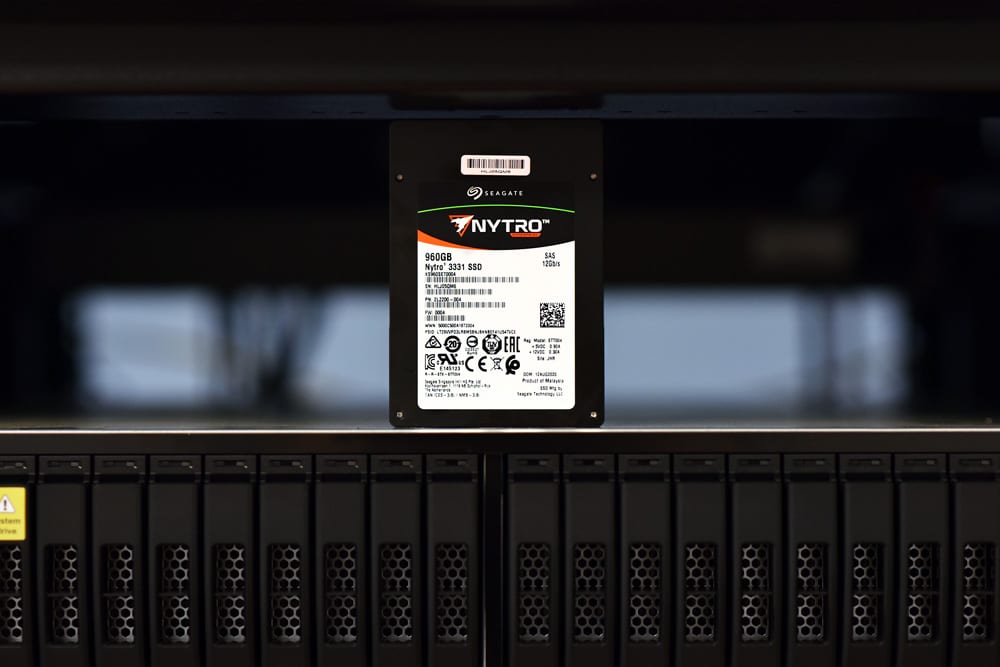
SAS is the less talked about interface leveraged in the data center, but still high prevalent. It doesn’t have the extreme performance of NVMe or the cost-efficiency of SATA. They fit in a nice middle ground. The Seagate Nytro 3031 SAS series is here to deliver high performance, security, and capacity to the SAS field. From a security and endurance standpoint, the drive leverages full internal and external data path protection (T10 DIF), advanced ECC algorithms, media lifecycle management, and other techniques for extending flash memory life.
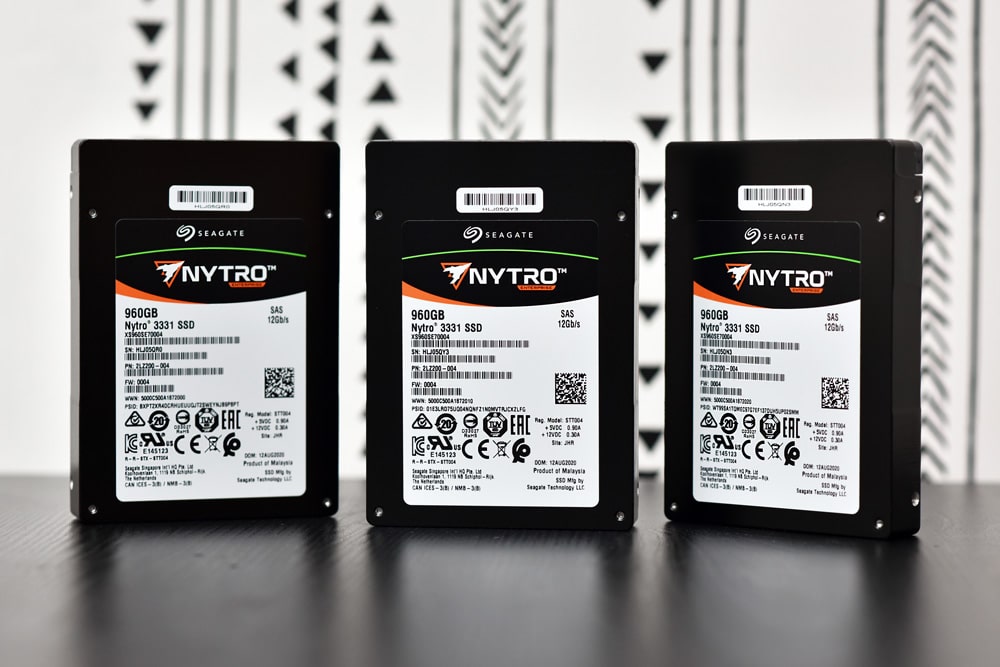
For performance the drive is dual-ported and has a maximum quoted speed of 2.2GB/s. There are several flavors of the drive. The one we are looking at, Seagate Nytro 3331 SAS SSD, is the scaled endurance model. The 3331 comes with capacities ranging form 960GB to 7.68TB but the 3031 series goes all the way up to 15.36TB for those that need it for read intensive workloads.
For this review we are looking at a 960GB version of the Seagate Nytro 3331 SAS SSD.
Seagate Nytro 3331 Specifications
| Capacity | 7.68TB | 3.84TB | 1.92TB | 960GB |
| Interface | Dual 12Gb/s SAS | |||
| NAND Flash Type | 3D eTLC | |||
| Form Factor | 2.5 in × 15mm | |||
| Performance—Single Port 12Gb\s | ||||
| Sequential Read (MB/s) Sustained, 128KB | 1100 | |||
| Sequential Write (MB/s) Sustained, 128KB | 1000 | |||
| Random Read (IOPS) Sustained, 4KB | 170,000 | 180,000 | 180,000 | 165,000 |
| Random Write (IOPS) Sustained, 4KB | 70,000 | 85,000 | 85,000 | 70,000 |
| Random 30% Write (IOPS) Sustained, 4KB | 140,000 | 160,000 | 150,000 | 120,000 |
| Performance—Dual Port 12Gb\s | ||||
| Sequential Read (MB/s) Sustained, 128KB | 2000 | 2200 | 2200 | 2150 |
| Sequential Write (MB/s) Sustained, 128KB | 1550 | 1550 | 1550 | 1000 |
| Random Read (IOPS) Sustained, 4KB | 230,000 | 230,000 | 230,000 | 210,000 |
| Random Write (IOPS) Sustained, 4KB | 70,000 | 85,000 | 80,000 | 70,000 |
| Random 30% Write (IOPS) Sustained, 4KB | 160,000 | 160,000 | 160,000 | 140,000 |
| Endurance/Reliability | ||||
| Lifetime Endurance | 1 Drive Writes per Day | |||
| Total Bytes Written (TB) | 13,600 | 6800 | 3400 | 1700 |
| Nonrecoverable Read Errors per Bits Read | 1 per 10E17 | |||
| Annualized Failure Rate (AFR) | 0.35% | |||
| Warranty, Limited (years) | 5 | |||
| Power Management | ||||
| +5/+12V Max Start Current (A) | 0.80/0.21 | |||
| Average Idle Power (W) | 4.4 | |||
| Physical | ||||
| Height (mm/in, max) | 15.00mm/0.591in | |||
| Width (mm/in, max) | 70.10mm/2.760in | |||
| Depth (mm/in, max) | 100.45mm/3.955in | |||
| Weight (g/lb) | 165g/0.364lb | |||
Performance
Testbed
Our Enterprise SSD reviews leverage a Lenovo ThinkSystem SR850 for application tests and a Dell PowerEdge R740xd for synthetic benchmarks. The ThinkSystem SR850 is a well-equipped quad-CPU platform, offering CPU power well in excess of what’s needed to stress high-performance local storage. Synthetic tests that don’t require a lot of CPU resources use the more traditional dual-processor server. In both cases, the intent is to showcase local storage in the best light possible that aligns with storage vendor maximum drive specs.
Dell PowerEdge R740xd
- 2 x Intel Gold 6130 CPU (2.1GHz x 16 Cores)
- 4 x 16GB DDR4-2666MHz ECC DRAM
- 1x PERC 730 2GB 12Gb/s RAID Card
- Add-in NVMe Adapter
- Ubuntu-16.04.3-desktop-amd64
Testing Background
The StorageReview Enterprise Test Lab provides a flexible architecture for conducting benchmarks of enterprise storage devices in an environment comparable to what administrators encounter in real deployments. The Enterprise Test Lab incorporates a variety of servers, networking, power conditioning, and other network infrastructure that allows our staff to establish real-world conditions to accurately gauge performance during our reviews.
We incorporate these details about the lab environment and protocols into reviews so that IT professionals and those responsible for storage acquisition can understand the conditions under which we have achieved the following results. None of our reviews are paid for or overseen by the manufacturer of equipment we are testing.
Comparables for this review:
VDBench Workload Analysis
When it comes to benchmarking storage devices, application testing is best, and synthetic testing comes in second place. While not a perfect representation of actual workloads, synthetic tests do help to baseline storage devices with a repeatability factor that makes it easy to do apples-to-apples comparison between competing solutions. These workloads offer a range of different testing profiles ranging from “four corners” tests, common database transfer size tests, to trace captures from different VDI environments. All of these tests leverage the common vdBench workload generator, with a scripting engine to automate and capture results over a large compute testing cluster. This allows us to repeat the same workloads across a wide range of storage devices, including flash arrays and individual storage devices. Our testing process for these benchmarks fills the entire drive surface with data, then partitions a drive section equal to 25% of the drive capacity to simulate how the drive might respond to application workloads. This is different than full entropy tests which use 100% of the drive and take them into steady state. As a result, these figures will reflect higher-sustained write speeds.
Profiles:
- 4K Random Read: 100% Read, 128 threads, 0-120% iorate
- 4K Random Write: 100% Write, 64 threads, 0-120% iorate
- 64K Sequential Read: 100% Read, 16 threads, 0-120% iorate
- 64K Sequential Write: 100% Write, 8 threads, 0-120% iorate
- Synthetic Database: SQL and Oracle
- VDI Full Clone and Linked Clone Traces
In our first VDBench Workload Analysis, Random 4K Read, the Seagate Nytro 3331 hit a peak of about 166K IOPS with a latency of about 650µs before dropping off some and placing third overall
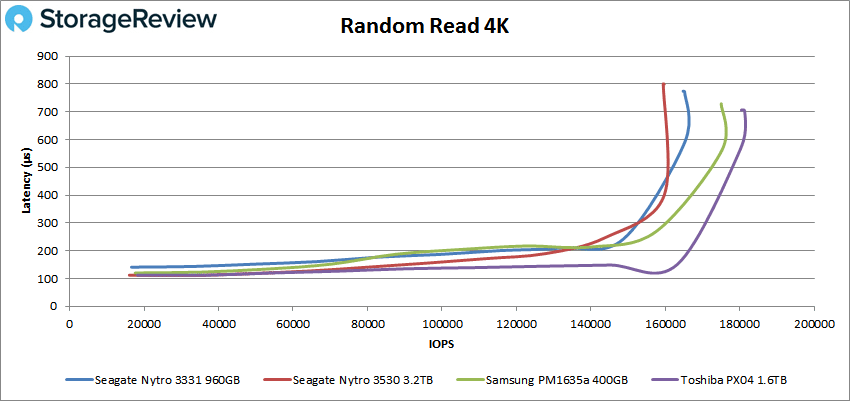 4K random write saw the 3331 hit third again with a peak of 138,143 IOPS at a latency of 913.2µs.
4K random write saw the 3331 hit third again with a peak of 138,143 IOPS at a latency of 913.2µs.
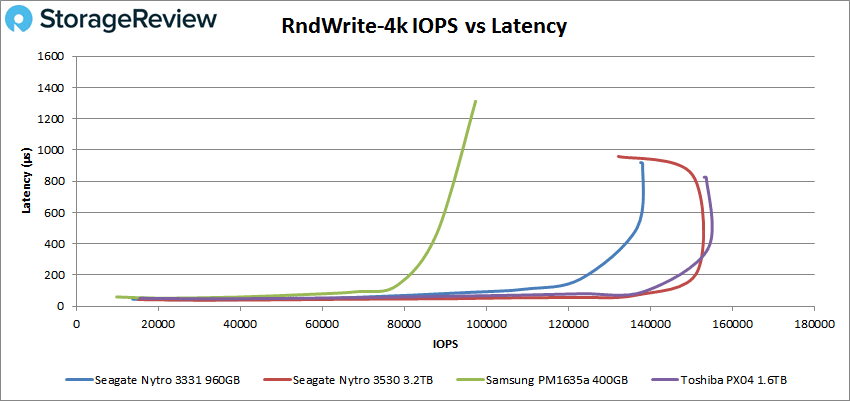 Switching to sequential, the 3331 stayed in third in 64K read with a peak of 16,433 IOPS or 916MB/s at a latency of 1.1ms.
Switching to sequential, the 3331 stayed in third in 64K read with a peak of 16,433 IOPS or 916MB/s at a latency of 1.1ms.
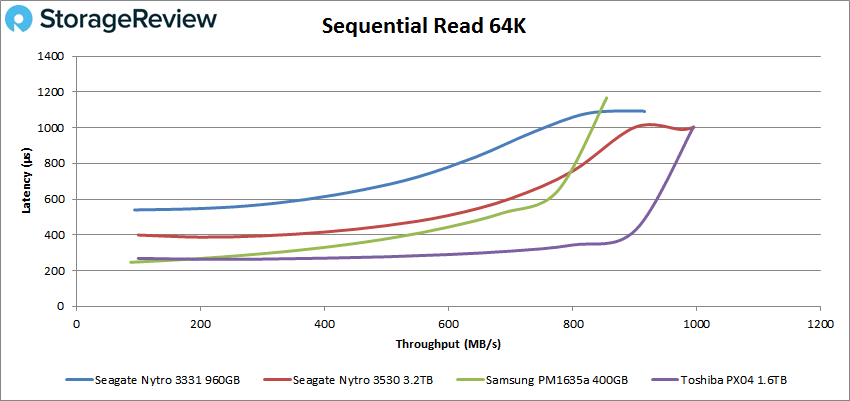 With 64K write saw the 3331 hang out in third with a peak performance of 9,690 IOPS or 606MB/s at a latency of 1.6ms.
With 64K write saw the 3331 hang out in third with a peak performance of 9,690 IOPS or 606MB/s at a latency of 1.6ms.
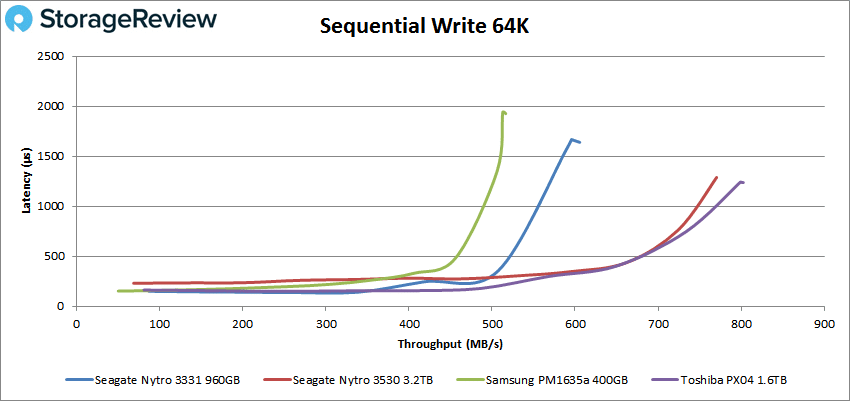 Our next set of tests are our SQL workloads: SQL, SQL 90-10, and SQL 80-20. Starting with SQL, the Seagate Nytro 3331 dropped to the bottom of the pack with a peak performance of 85,407 IOPS and a latency of 374µs.
Our next set of tests are our SQL workloads: SQL, SQL 90-10, and SQL 80-20. Starting with SQL, the Seagate Nytro 3331 dropped to the bottom of the pack with a peak performance of 85,407 IOPS and a latency of 374µs.
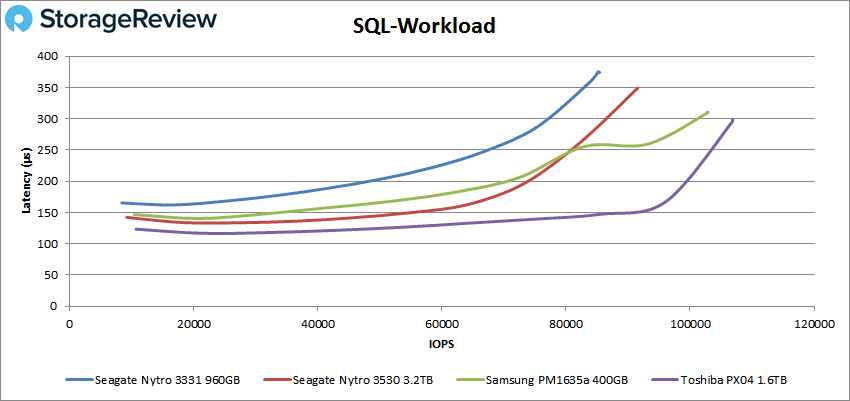 SQL 90-10 gave us a peak of 94,710 IOPS with a latency of 337µs for the 3331, once again back in third.
SQL 90-10 gave us a peak of 94,710 IOPS with a latency of 337µs for the 3331, once again back in third.
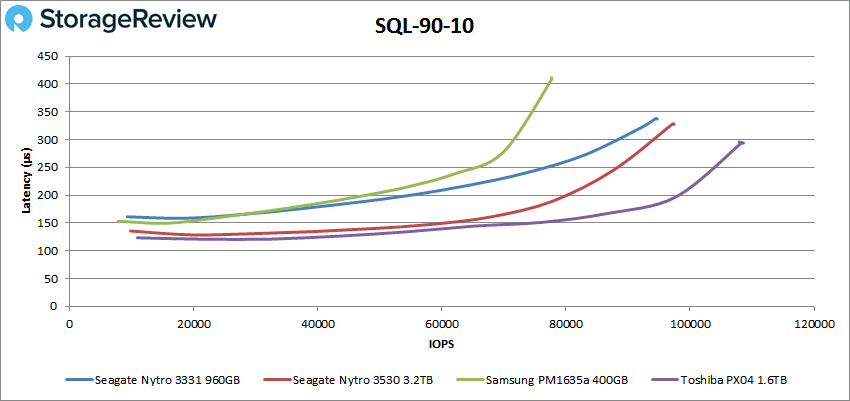 Still in third for SQL 80-20, the 3331 peaked at 91,608 IOPS at a latency of 348µs.
Still in third for SQL 80-20, the 3331 peaked at 91,608 IOPS at a latency of 348µs.
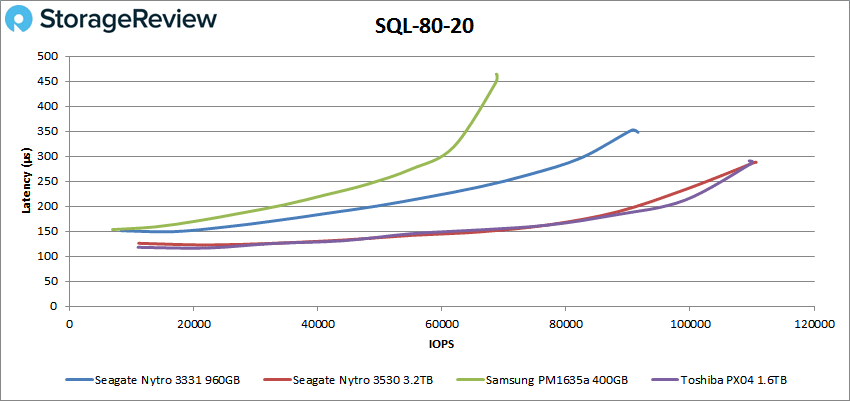 Next up are our Oracle workloads: Oracle, Oracle 90-10, and Oracle 80-20. Starting with Oracle, the Seagate Nytro 3331 stayed in its favorite place and peaked at 97,332 IOPS at a latency of 358µs.
Next up are our Oracle workloads: Oracle, Oracle 90-10, and Oracle 80-20. Starting with Oracle, the Seagate Nytro 3331 stayed in its favorite place and peaked at 97,332 IOPS at a latency of 358µs.
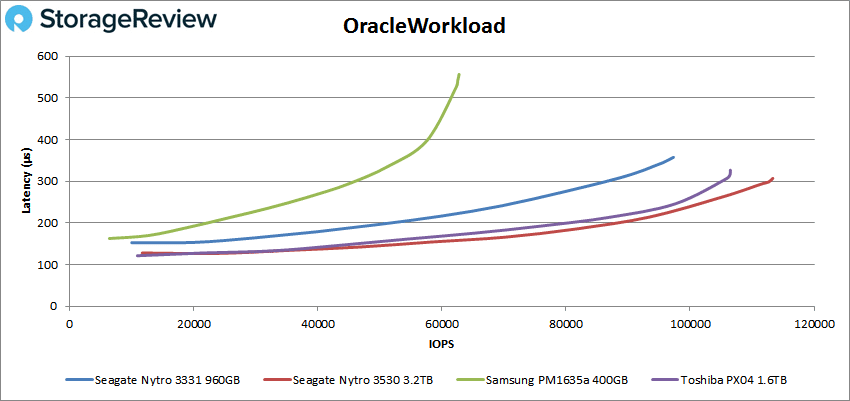 For Oracle 90-10 the 3331 peaked at 85,961 IOPS at a latency of 254µs, once more staying right there in third place.
For Oracle 90-10 the 3331 peaked at 85,961 IOPS at a latency of 254µs, once more staying right there in third place.
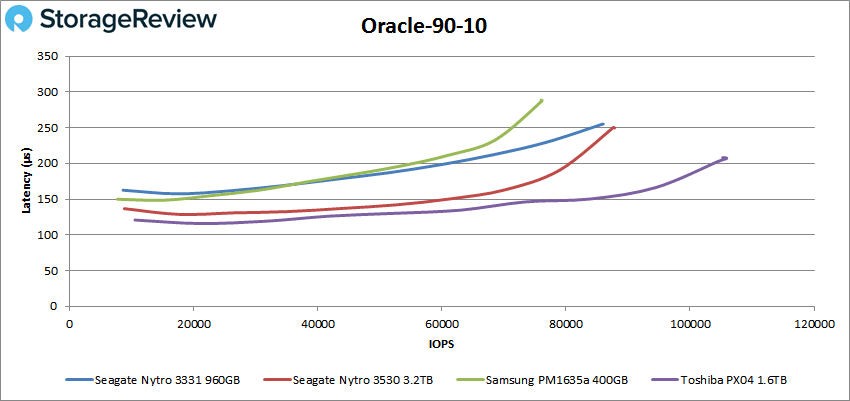 Oracle 80-20 showed the same placement of the 3331 with a peak score of 85,924 IOPS and a latency 256µs.
Oracle 80-20 showed the same placement of the 3331 with a peak score of 85,924 IOPS and a latency 256µs.
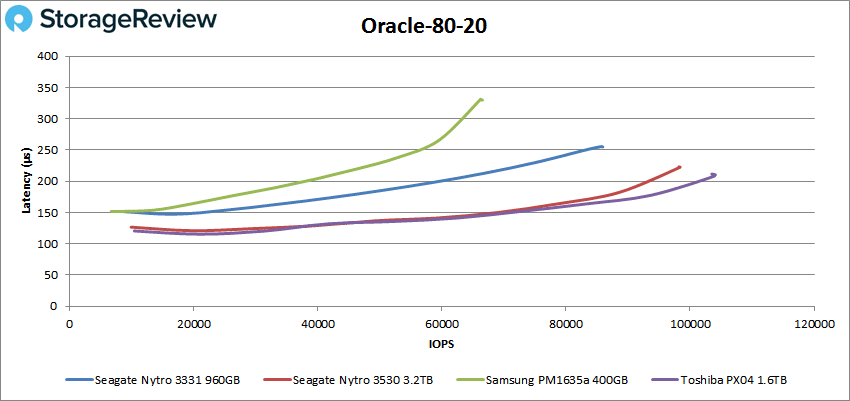 Next, we switched over to our VDI clone test, Full and Linked. For VDI Full Clone (FC) Boot, the Seagate Nytro 3331 fell to last place with a peak of 49,853 IOPS and a latency of 649µs.
Next, we switched over to our VDI clone test, Full and Linked. For VDI Full Clone (FC) Boot, the Seagate Nytro 3331 fell to last place with a peak of 49,853 IOPS and a latency of 649µs.
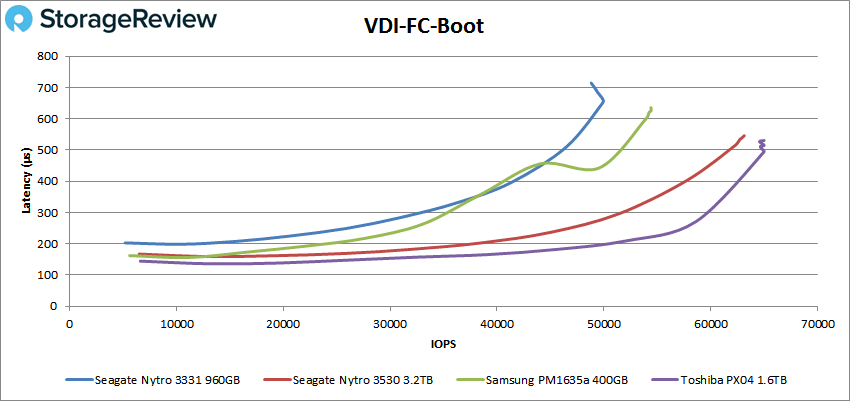 For VDI FC Initial Login saw the 3331 climb back to third with a peak of 28,762 IOPS at a latency of 1.03ms.
For VDI FC Initial Login saw the 3331 climb back to third with a peak of 28,762 IOPS at a latency of 1.03ms.
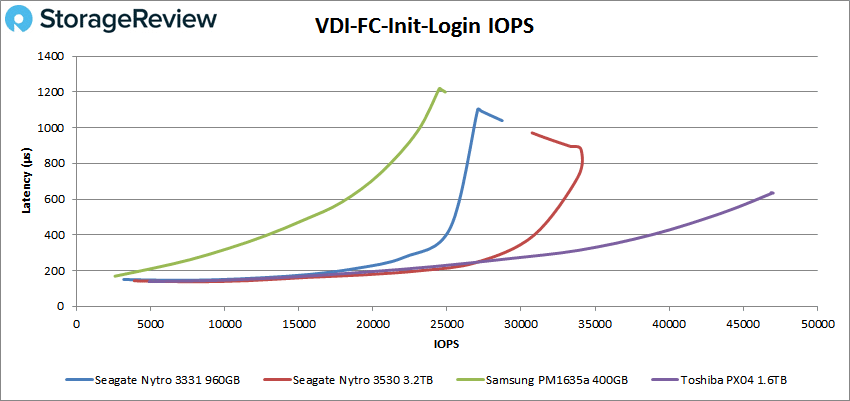
VDI FC Monday Login had the 3331 in saw the same placement with a peak of 31,888 IOPS and a latency of 499µs.
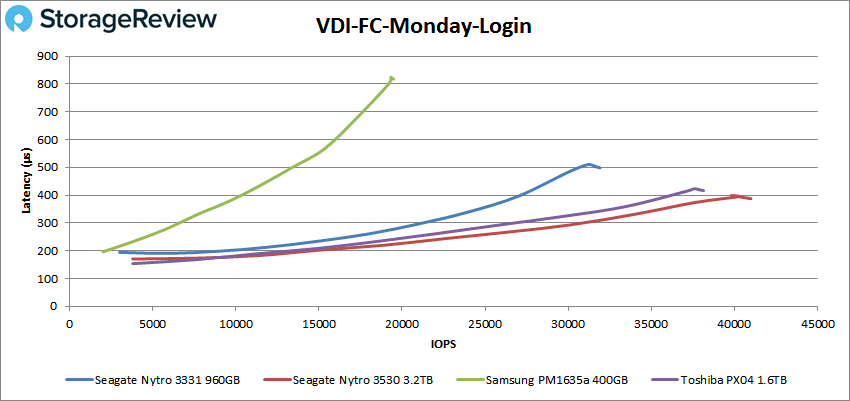 For VDI Linked Clone (LC) Boot, the 3331 dropped to last place with a peak score of 26,268 IOPS and a latency of 607µs.
For VDI Linked Clone (LC) Boot, the 3331 dropped to last place with a peak score of 26,268 IOPS and a latency of 607µs.
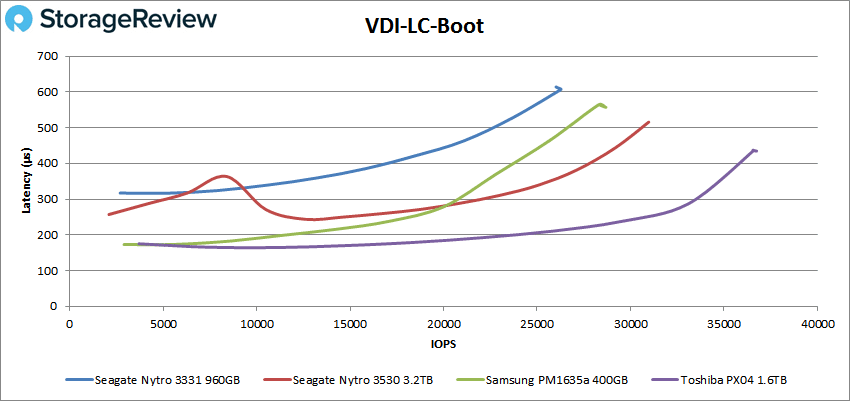 VDI LC Initial Login had the 3331 take third with a peak performance of 16,701 IOPS and a latency of 475µs.
VDI LC Initial Login had the 3331 take third with a peak performance of 16,701 IOPS and a latency of 475µs.
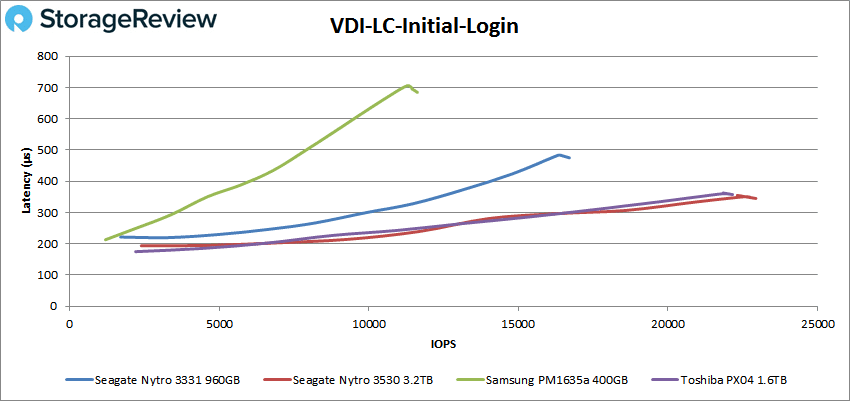 Finally, VDI LC Monday Login saw the 3331 take third with a peak of 22,188 IOPS and 719µs for latency.
Finally, VDI LC Monday Login saw the 3331 take third with a peak of 22,188 IOPS and 719µs for latency.
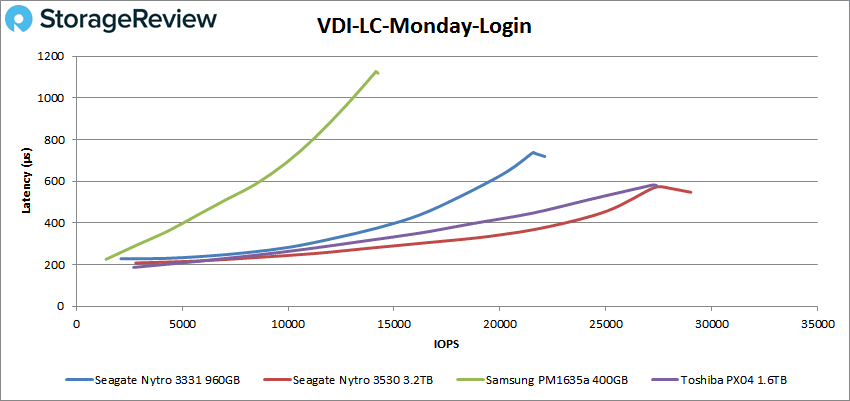 Conclusion
Conclusion
The Seagate Nytro 3331 is part of the company’s enterprise SAS line of SSDs. The drive can act as a higher performat, more secure SAS drive as organizations expand their SAS foot print or upgrade older SAS HDDs with these high capacity SSDs. The drive comes in capacities as high as 7.68TB and leverage several security options from Seagate. The 3331 in particular is the scaled endurance version of the SAS drives offering up to 1DWPD and up to 13,600 TBW.
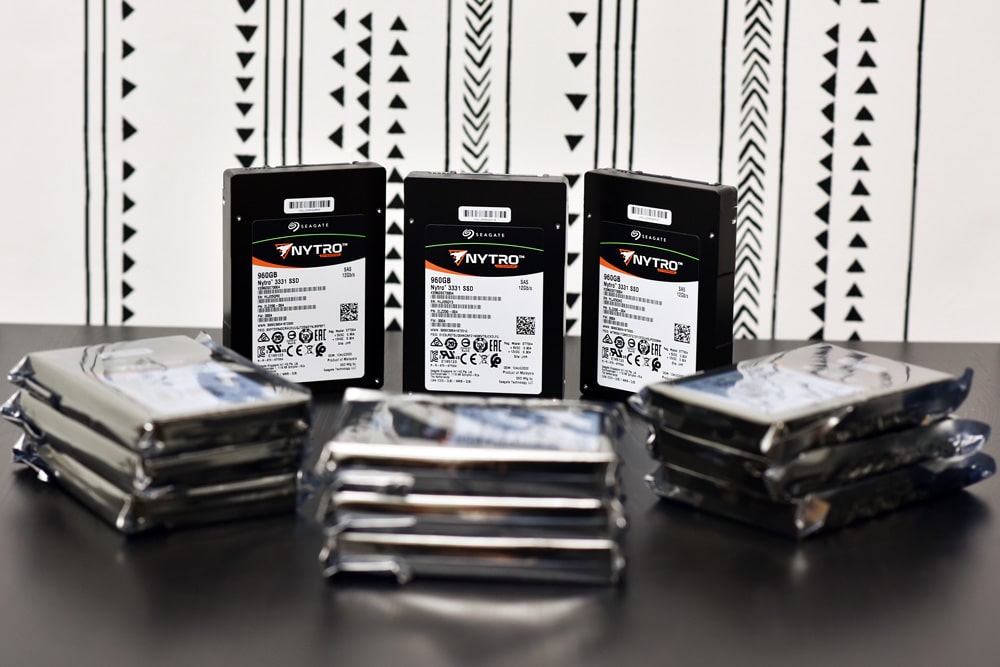
It has been a minute since we reviewed a SAS SSD. They are becoming less bleeding edge with NVMe taking the limelight, but still needed for many arrays and dual controller platforms. For this review we ran our VDBench workloads. Overall the drive didn’t perform spectacularly, comparatively speaking. Highlights include 166K IOPS for 4K read, 4K write saw 138K IOPS, 916MB/s in 64K read, and 606MB/s in 64K write. For SQL we saw 85K IOPS, 95K IOPS in SQL 90-10, and 92K IOPS SQL 80-20. For Oracle we saw 97K IOPS, 86K IOPS for Oracle 90-10, and 86K IOPS for Oracle 80-20. In our VDI clone testing we saw 50K IOPS in boot, 29K IOPS in initial login, and 32K IOPS in Monday login for Full Clone. In Linked Clone we saw 26K IOPS in boot, 17K IOPS in initial login, and 22K IOPS in Monday login.
The Seagate Nytro 3331 brings security, capacity, and decent performance for those that need to leverage SAS in their data center.
Engage with StorageReview
Newsletter | YouTube | Podcast iTunes/Spotify | Instagram | Twitter | Facebook | RSS Feed
